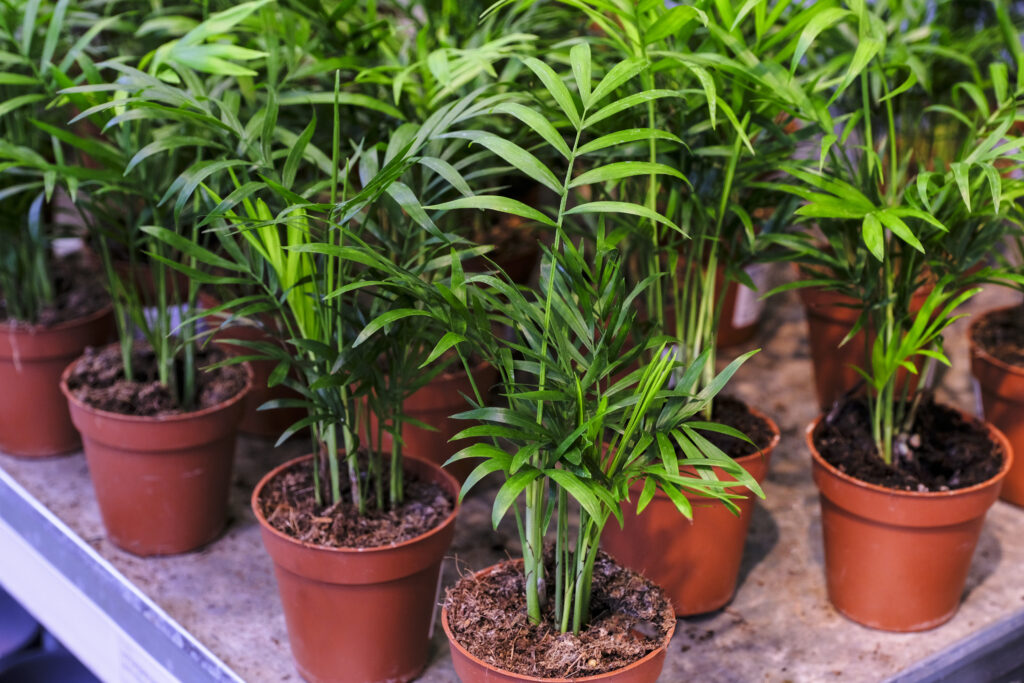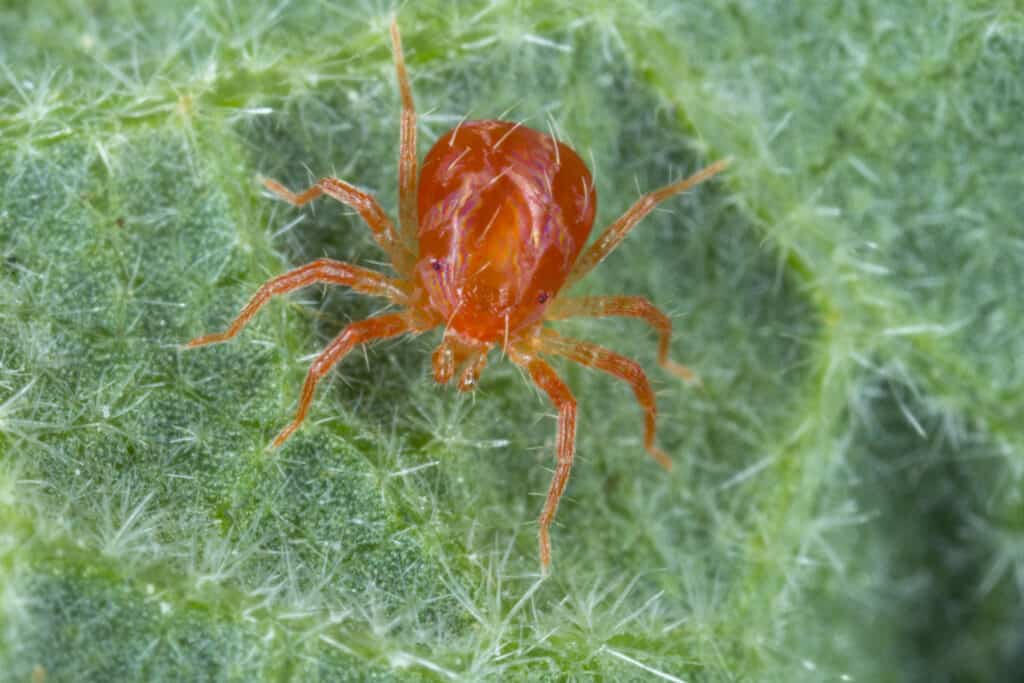One of the most popular houseplant palms available today is the parlor palm. The Americas’ subtropical and tropical climates are home to parlor palms. This species can reach heights of well over six feet with proper care and frequent repottings. Repotting should only be done every two to three years, though, since they dislike having their roots disturbed. This plant produces inedible fruit from blooms at the base of the plant. This makes the parlor palm quite interesting, as its closely-related cousins, coconuts and dates, produce edible fruit from flowers at the top of the plant. This species of palm, which has been grown since the Victorian era, is appreciated for its reliability and resilience in indoor spaces.
Do you want to keep your own parlor palm plant? Let’s explore some interesting facts about the parlor palm and break down the basics of how to care for one indoors.
What is the Parlor Palm?
The parlor palm, also known as the parlour palm and the neanthe bella palm, is a species of palm tree classified as Chamaedorea elegans. It is also sometimes called the bamboo palm, though this is usually due to confusing this plant with Chamaedorea seifrizii. It is part of the Arecaceae family. The parlor palm is native to forests in Guatemala and southern Mexico. It is a tropical plant and also a smaller species of palm tree compared to large species like the areca palm and coconut palm.
The parlor palm is a woody, rhizomatous plant with a thin green stem that is native to tropical regions. It can reach heights of six to 10 feet, and in exceptional instances, 13 to 16 feet. It features upright buds, pierced crescent-shaped leaves, a half-inch-long ringed stigma, flexible tubular stems without spines, and typically pinnate foliage. When fully grown, the crown will have three to 10 additional leaves. This species is notable for its early age of flowering, with some plants blossoming at just one foot in height.
On irregularly branching leafstalks that grow below or amid the leaves, the parlor palm’s tiny, fragrant, yellow or orange-red blooms can be seen. They appear as lateral buds on the trunk and open as clusters of tiny balls without petals. Sometimes, pea-sized, quarter-inch-diameter, black berries will grow after flowering and are gathered in paniculate inflorescences.
The temperate parlor palm is commonly grown as a houseplant and in gardens in the southeastern region of the United States, where it grows slowly to six feet tall. Most often, it is marketed and planted in lots of five to 30 seedlings. The weaker and smaller seedlings are forced out of the way for light and eventually perish, leaving after a few years of purchase a few survivors that form stems and can live for many decades in a pot. Over time, a limited number of emerging plants will survive. If you wish to grow this plant outdoors, you must live in USDA hardiness zones 10 through 12. This plant is known for growing quite slowly.
The parlor palm is thought to have at least two naturally occurring varieties, one of which grows at lower elevations and has a thinner stem than the highland variety. There are a few varieties that stand out, such as one with dark-leaved leaves. They are uncommon, and the majority of what is offered in stores is the typical brilliant green base variety.

Parlor palms (pictured) are often cultivated and sold in bunches or clusters to make them look thicker and more aesthetically-pleasing.
©iStock.com/Olga Ostapenko
How to Care for a Parlor Palm Plant
One of the most common indoor palms planted in most temperate nations is the parlor palm, which is valued for its ability to tolerate lower temperatures and adapt to relatively low light. Parlor palms are an excellent houseplant for beginners to start out with out of all the palm plants in the market today. In a northern exposure or entryway, these plants thrive particularly well in three-gallon pots that are around 10 inches wide, where they can display their fine-textured leaves. Just keep in mind that a major killer of this plant is, surprisingly, too much attention. Either by getting too much direct sunshine or overwatering, these plants can die because they are sensitive to too much water and prefer lower light conditions.
Like many palm plant species, parlor palm plants are very sensitive to getting too much water and cannot handle being waterlogged or languishing in very wet potting mix. To ensure your parlor palm survives, make sure it has a constant amount of wetness in its soil. Instead of overwatering, err on the side of little too much dryness. When the top inch of soil seems very dry to the touch, water it. If the plant’s fronds become yellow, it requires additional water.
Room temperatures between 65 and 80 degrees F are ideal for the parlor palm. It can withstand lows of 50 degrees F, but if touched by frost at any point, it will perish. Keep this species away from drafts that can come in from windows, vents, and outside doors. Even with just moderate humidity, it will flourish. The most likely culprits for your palm’s dry leaf edges or brown tips are cold gusts or extended dry spells. Before giving it more water, increase the humidity levels to correct the condition.
While they are regarded as low-light plants, parlor plants need at least some light to survive. In fact, all plants need some light to live. The ideal light exposure for parlor palms is bright and filtered sunshine. They do best when placed near a window facing north.
Any excellent peat-based potting mix can be used for parlor palms. Make sure the mixture doesn’t degrade and become spongy, and instead drains well. This palm will thrive in practically any type of soil outside, whether it be loamy, clay, or sand. Salty soil, however, can cause problems for this species. Throughout the growing season, treat your parlor palm’s soil with a dilute liquid fertilizer once or twice. Absolutely do not fertilize at all during the winter! These plants require little food and even less when dormant in the wintertime.
Because of their sluggish growth and thin root systems, parlor palms should be replanted or repotted carefully. Generally speaking, these plants will stay at a reasonable size, so you shouldn’t need to repot them more often than every two years. Repot your parlor palm plant if your potting medium degrades and turns mucky or sponge-like to avoid root rot.

Parlor palms (pictured) need well-draining soil, adequate humidity, and access to indirect, bright sunlight in order to maintain its vibrant foliage.
©iStock.com/ELENA PETRUNEVA
How to Propagate a Parlor Palm
Professional growers almost always propagate these plants from seeds. You could technically split a parlor palm clump into two smaller plants, but doing this is not advised since it will place too much stress on the plant and its roots. Although not naturally clumping, the plants are usually cultivated in clumps for aesthetic purposes. They cannot be propagated by leaf or stem cuttings like other palms. Home gardeners should generally avoid trying to propagate this species and instead choose to purchase a new one if needed.
Problems, Diseases, and Pests to Watch Out For
When indoor parlor palms are left in overly damp or saturated soil for extended periods of time, root rot becomes a very chronic problem. Rapid leaf yellowing, reduced development, and a decaying brown base are symptoms of root rot. Examine the plant’s health below the soil level after removing it from the pot. You’re okay to go if the roots have a golden tint to them, but you need to act right away if they’re mushy and brown. Transplant your damaged parlor palm into a pot with very good drainage.
When it comes to forceful repots, transplant shock is a significant problem for parlor palms. Keep in mind that these are delicate plants! Give the plant a good bath a day before the repotting event and avoid fiddling with the roots. Underwatering is a significant cause of transplant shock, and the most prevalent symptoms are wilting leaves, yellowing leaves, and stunted development.
Low humidity levels might result in yellow haloes surrounding browning leaf tips of your parlor palm. While this won’t harm your specimen, you will want to provide more moisture to the area around your plant to stop the new growth from displaying these symptoms. Mist or clean the leaves occasionally and place the plant’s pot on a humidity tray to keep up a stable atmosphere for your parlor palm.
Lower leaves that are near the soil may yellow as a result of overwatering, but this is also a sign of maturity. Overwatering can be at fault if older leaves quickly start to turn yellow one after another. Many are unaware that plants’ roots require access to oxygen as well; when soil is watered, air will rise up and escape from the potting soil. The roots will deteriorate during the following days due to a lack of readily available oxygen. As such, your parlor palm will need very well-draining soil and a pot with plenty of drainage holes.
The presence of mold in your parlor palm’s soil indicates both inadequate lighting and excessive irrigation. Although the mold is not necessarily dangerous, most gardeners find it to be an eyesore. The top two inches of the soil should be taken out and replaced with fresh, new potting soil. Either make more light available or slightly reduce the frequency of which you water this plant. You could also potentially have root rot if the mold is followed by yellowing lower leaves.
Parlor palms are susceptible to numerous types of leaf spot diseases, including graphiola, botrytis, anthracnose, and cercospora. They all function in the same way. As the plant steadily grows, fungi spores will fall to the surface of the leaf. Unfortunately, you can only prune the affected leaves and thoroughly wash the unaffected leaves to stop the spread because there are no solutions that will tackle the problem directly. While treating it, keep the plant apart from your unaffected houseplants for at least one month.
Pest infestations can originate in the original nursery that you bought the plant from or through household contamination, and they can happen at any moment. The typical residents are spider mites and mealybugs, with the first being tiny and nearly transparent and scouring the leaves for chlorophyll and a place to bury its eggs. The latter, however, will be considerably more noticeable as white cottony webs form on the stems and leaves. Neem oil is an excellent treatment for these pests.

Spider mites (pictured) can cause serious problems for parlor palms.
©Tomasz Klejdsz/Shutterstock.com
The parlor palm is a bit delicate, but it is an excellent tropical palm to keep indoors if you can handle its care requirements. Its deep green leaves and elegant appearance have made it a fan favorite among tropical plant collectors, and it would look lovely in any room in your home!
The photo featured at the top of this post is © iStock.com/Wheatfield
Thank you for reading! Have some feedback for us? Contact the AZ Animals editorial team.







